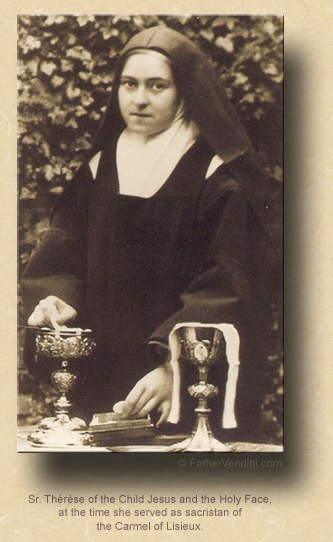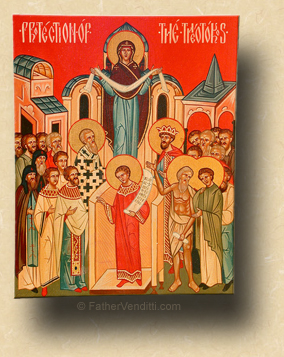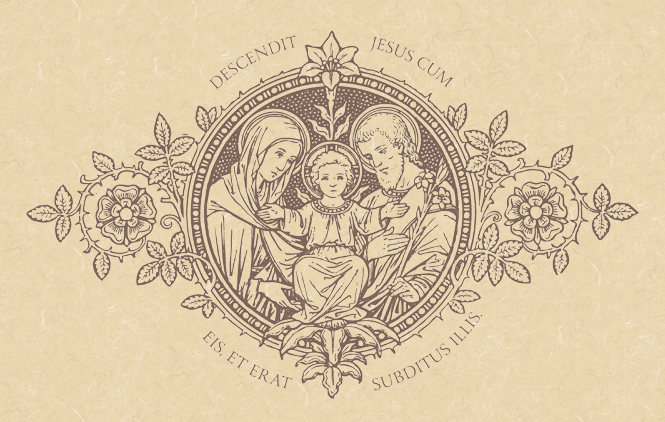Of Merton and Martin.
The Memorial of Saint Thérèse of the Child Jesus, Virgin & Doctor of the Church.
Lessons from the proper, according to the ordinary form of the Roman Rite:
• Isaiah 66: 10-14.
• Psalm 131: 1-3.
• Matthew 18: 1-4.
|
…or, from the primary feria for the Twenty-Sixth Tuesday of Ordinary Time:
• Zechariah 8: 20-23.
• Psalm 87: 1-7.
• Luke 9: 51-56.
…or, any lessons from the common of Virgins, or the common of Holy Men & Women for Religious.
|
The Sixteenth Tuesday after Pentecost; and, the Commemoration of Saint Remigius, Bishop & Confessor.*
Lessons from the dominica,** according to the extraordinary form of the Roman Rite:
• Ephesians 3: 13-21.
• Psalm 101: 16-17.
• Luke 14: 1-11.
The Solemn Holy Day of the Protection of the Theotokos & Ever Virgin Mary; the Feast of the Holy Apostle Ananias; and, the Feast of Our Venerable Father Romanos the Hymnographer.***
Lessons from the menaion, according to the Ruthenian recension of the Byzantine Rite:
• Hebrews 9: 1-7.
• I Corinthians 4: 9-16.
• Luke 10: 38- 42; 11: 27-28.
• Luke 10: 16-21.
FatherVenditti.com
|
 5:06 PM 10/1/2019 — You'll probably be surprised to learn that one of the books that had an enormous influence over me in my youth was the Tao Te Ching, reputedly written around the 6th century BC by the Chinese philosopher, Lao-Tsu, who is traditionally regarded as the founder of the philosophical and religious movement known as Taoism. At the time, I was giving serious consideration to a monastic vocation, and was drawn to read the work because of another book I had read by Thomas Merton, in which he did a comparison between the basic tenants of Taoism and the “Little Way” of Saint Thérèse of the Child Jesus and the Holy Face, whose memorial we celebrate today. 5:06 PM 10/1/2019 — You'll probably be surprised to learn that one of the books that had an enormous influence over me in my youth was the Tao Te Ching, reputedly written around the 6th century BC by the Chinese philosopher, Lao-Tsu, who is traditionally regarded as the founder of the philosophical and religious movement known as Taoism. At the time, I was giving serious consideration to a monastic vocation, and was drawn to read the work because of another book I had read by Thomas Merton, in which he did a comparison between the basic tenants of Taoism and the “Little Way” of Saint Thérèse of the Child Jesus and the Holy Face, whose memorial we celebrate today.
Of course, there are a lot of differences between the two, not the least of which being that historians now contend that Lao-Tsu never really existed, and that the Tao Te Ching is a compilation of sayings put together in the 4th and 5th centuries by many individuals, particularly a man named Chang-Tsu, from whose writings we know pretty much everything we know about Taoist philosophy. Another important difference is that the way of complete abandonment and making oneself invisible in a spirit of complete humility that was the cornerstone of both spiritual approaches had very different focal points: Taoism's goal is to enable one to achieve complete inner peace and harmony with everyone and everything, and the Little Flower would agree with that; but, for her, inner peace and balance of life are not goals in themselves, but a way of more perfectly living the Gospel of Our Lord, God and Savior, Jesus Christ. In other words, one is focused on oneself, while the other is focused entirely on God, which the Taoist wouldn't necessarily disagree with except that, for him, god is not a person; he's just a state of being. That being said, you could take some sayings from the Tao Te Ching and some isolated statements from the spiritual notebooks of Saint Thérèse and jumble them together on a piece of paper and you wouldn't be able to determine which was which; and yet, it is absolutely clear that Saint Thérèse never read the Tao Te Ching. She was a very transparent individual; her spiritual notebooks are very candid, and she tells us pretty much everything else she read; so, if she had read the Tao Te Ching she would have said so.
I don't know how much you know about Thomas Merton, but he seemed to have jumped the rails toward the end of his life. He had left the Abbey of Gethsemane in Kentucky, presumably with the permission of his abbot, to attend a pan-religious monastic conference in Thailand which was to be a meeting of monks and mystics from every religious tradition that had a monastic element to it, and it was there that he died.  Reading only his essays and letters from that period without knowing the source, you might be hard pressed to identify the author as a Christian. Those who have read his recently published journals—which I haven't—tell a different story; but, it seems to me that he had lost his own focus on Jesus Christ as the source and goal of authentic spirituality, betraying the extent to which he had actually failed to appreciate the spirituality of the Little Flower which he had so admired in the past. That's just my opinion. Reading only his essays and letters from that period without knowing the source, you might be hard pressed to identify the author as a Christian. Those who have read his recently published journals—which I haven't—tell a different story; but, it seems to me that he had lost his own focus on Jesus Christ as the source and goal of authentic spirituality, betraying the extent to which he had actually failed to appreciate the spirituality of the Little Flower which he had so admired in the past. That's just my opinion.
As to Saint Thérèse herself, you know the particulars of her life as well as I: born Marie Françoise Thérèse Martin in Alençon in France on January 2nd, 1873; lost her mother at the age of five; was sent to the Benedictine nuns in Lisieux at the age of nine for her education; suffered from a mysterious illness from which she claimed to be cured through the intercession of Our Lady of Victory; aspired to enter the Order of Discalced Carmelites in Lisieux but was rejected because of her age, but persevered until they finally accepted her at the age of fifteen; there she began to develop what became known as her “Little Way” of complete abandonment to Christ and, although never served as novice mistress, was pressed upon to give conferences to the novices on this subject; and, died of tuberculosis on September 30th, 1897, at the age of twenty-four. Pope Pius XI both beatified and canonized her, declaring her patroness of the missions, and Pope Saint John Paul II proclaimed her a Doctor of the Church.
What I find remarkable about her—and it comes out very clearly in her autobiography, Story of a Soul—is what a mature and calm individual she was, which she would have to be to embrace the approach to the Gospel that she took, and which probably caused Thomas Merton, in his mental confusions, to misinterpret her so profoundly: she was one of these people that you could light firecrackers under her chair and she wouldn't blink. And while there's a pile of stuff that one could say about her on her feast day, there's a quality about her that may be more prescient than others that could be of benefit for us today: we watch the news, we see moral depravity all around us, we see the threat of terrorism all over the world, we see the breakdown of religion and even have doubts sometimes about the future of the Church; had Saint Thérèse lived today, she wouldn't let any of this bother her; she never let anything bother her. She knew what she was about, and she had such a profound immersion in the Virtue of Hope that she couldn't doubt the future of anything. That's one of the reasons why she's a saint, and is the perfect patron to pray to for those of us who tend to get excited and upset and despondent about things that we really can't do anything about.
Lao-Tsu, had he existed, would've been proud to have the same thing said about himself, but he wouldn't have understood—nor cared about, for that matter—the reason for it all; she knew the reason, and so do we: “Amen, I say to you, unless you turn and become like children, you will not enter the kingdom of heaven. Whoever humbles himself like this child is the greatest in the kingdom of heaven” (Matt. 18: 3-4 NABRE).

* Remigius, Bishop of Rheims, converted the Merovingian king Clovis and the Frankish nation, finally bring the whole of France into the Church. He died in the year 534. For some reason, the Missal of St. John XXIII does not indicate a Mass available for this commemoration; but, as usual, an additional Collect, Secret and Postcommunion are added to those of the feria.
** In the extraordinary form, on ferias outside privileged seasons, the lessons from the previous Sunday are repeated.
 *** The Solemn Holy Day of the Protection is one of the most important feasts on the Byzantine calendar. It commemorates an appearance of the Mother of God near Constantinople in the tenth century, during the siege of Constantinople by the Vandals. During services in the Church of Our Lady of the Waves in Blachernes, which was a seaside monastery on the outskirts of Constantinople, St. Andrew and his disciple, St. Epiphanius, saw the Mother of God approaching the ambo. She was supported by many saints. Here She knelt in prayer before the Holy Table, Her face bathed in tears. After praying, She took off her veil and extended it over the people as a sign of Her protection. In the popular icon of this event, the Theotokos is seen standing above the faithful, Her arms outstretched in prayer and draped with a veil. St. Andrew and St. Epiphanius are shown along with many other saints. In the center of the church, on the ambo, stands a young man, clothed in a deacon’s sticharion, and holding in his left hand an open scroll with the text of the Christmas Kontakion written on it; he is St. Romanos the Melodist, the famous hymnographer whose feast is also celebrated on October 1st, and who is responsible for having composed many of the troparia and kontakia sung in the Liturgy of the Byzantine Churches. Pope-emeritus Benedict regarded Romanos as a Father of the Church, and devoted one of his weekly audience addresses to his life and work. A massive icon of the Protection graces the ceiling of St. Michael the Archangel Byzantine Catholic Church in Allentown, Pennsylvania, where I was pastor for over thirteen years. *** The Solemn Holy Day of the Protection is one of the most important feasts on the Byzantine calendar. It commemorates an appearance of the Mother of God near Constantinople in the tenth century, during the siege of Constantinople by the Vandals. During services in the Church of Our Lady of the Waves in Blachernes, which was a seaside monastery on the outskirts of Constantinople, St. Andrew and his disciple, St. Epiphanius, saw the Mother of God approaching the ambo. She was supported by many saints. Here She knelt in prayer before the Holy Table, Her face bathed in tears. After praying, She took off her veil and extended it over the people as a sign of Her protection. In the popular icon of this event, the Theotokos is seen standing above the faithful, Her arms outstretched in prayer and draped with a veil. St. Andrew and St. Epiphanius are shown along with many other saints. In the center of the church, on the ambo, stands a young man, clothed in a deacon’s sticharion, and holding in his left hand an open scroll with the text of the Christmas Kontakion written on it; he is St. Romanos the Melodist, the famous hymnographer whose feast is also celebrated on October 1st, and who is responsible for having composed many of the troparia and kontakia sung in the Liturgy of the Byzantine Churches. Pope-emeritus Benedict regarded Romanos as a Father of the Church, and devoted one of his weekly audience addresses to his life and work. A massive icon of the Protection graces the ceiling of St. Michael the Archangel Byzantine Catholic Church in Allentown, Pennsylvania, where I was pastor for over thirteen years.
The lessons for this day are all from the menaion: the first and third are for the Mother of God, the second and fourth for the Apostle Aninias; since the Hymnographer has always shared this feast with the Theotokos, there are no additional lessons prescribed for him.
|

